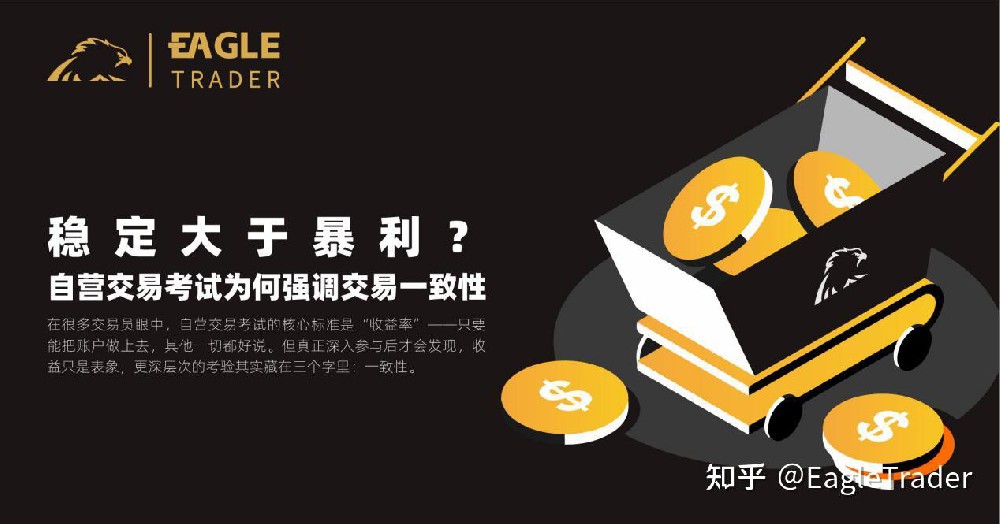In the eyes of many traders, the core standard of the proprietary trading exam is "return rate" - as long as the account can be made, everything else is easy to say. But after real in-depth participation, you will find that benefits are just appearances, and deeper tests are actually hidden in three words: consistency.

Especially, examination platforms that simulate real environments, such as EagleTrader, have introduced an additional "hidden scoring mechanism" in the transaction process - transaction consistency scoring. It will not directly affect the examination score, but it truly reflects the platform's emphasis on "long-term capabilities".
Trading consistency is a sign of traders' "professionality".
The so-called transaction consistency does not mean making a profit every time, but whether you can:
Execute trading plans according to the established logic, rather than temporarily starting;
Continue the style to maintain a stable style when facing different market environments, rather than jumping as soon as the market changes;
Accept losses but not losing positions, accepting drawdowns but not turning the table mentality;
Have your own rhythm, instead of imitating and following orders when looking at other people's returns.
In other words, consistency is a comprehensive manifestation of whether a trader has a "trading system" and whether he has "self-control". In the self-operated exam, it is the core standard for judging whether you "rely rely on strength" or "rely on luck".
This is also why, when many traders who pass the proprietary trading exam look at their account curve, the first thing they look at is not the returns, but: Is it stable or not? Is it a mess? Have you collapsed your original system?
Why do you value consistency?
From the platform:
On the EagleTrader platform, the trader exam is conducted under strict risk control constraints - risk control parameters such as the maximum daily loss, maximum drawdown, and minimum trading days simulate the real trading environment, with the purpose of allowing traders to show their strategies in constraints.
But even under these mechanisms, the platform still designs an independent consistency scoring mechanism as a "soft inspection method".
For a self-operated trading platform, the core of cooperation is not to bet or make a profit.High returns, but looking for traders who can output stably in long-term cycles and under multiple market fluctuations.
From the platform perspective, a trader with clear style, stable behavior and strong stress resistance goes farther than a person who wins by just one market bet.
From the trader's perspective:
Many traders are not afraid of losing money, but are afraid of not knowing why they lose money. The consistency score can give such feedback:
Do you frequently switch directions, resulting in confusion in style?
Do you lose control and increase your position before the big market comes and deviate from the original strategy?
Do you are eager to turn the profits due to losses, resulting in risk exposure?
This is not a simple digital game, but a very direct "style diagnosis".
For example, a trader suffered a pullback due to frequent positions increase in the EagleTrader exam, but he was not sure whether it was emotions that dominated the operation or the flaws of the strategy itself. After reviewing the consistency score, I found that my trading rhythm and incoherent direction during the market fluctuation were the root cause of failure.
For many traders who want to develop professionally, consistency scores can remind you of where you are out of control and where you are changing styles. It is a valuable feedback mechanism.
Consistency scores will not determine whether you pass, but whether you can go far
EagleTrader data shows that many traders with higher consistency scores may not necessarily have the most outstanding final returns, but they are more likely to go long after passing the exam. For example, maintain profits during the profit sharing stage, enter the Eagle Plan to increase its own profit sharing ratio, etc.
The reason is very simple: behind consistency is the system, discipline, and resistance to stress. These abilities are the long-term guarantee for a qualified trader.
For many traders, the self-operated trading exam is a challenge and a self-calibration. If you always feel that you are still some distance away from a "maturity trader", you might as well pay attention to your trading consistency.
It is not a platform to judge your score, but a mirror of trading behavior that you look at for yourself.
If you also want to test the integrity and execution of your system on a platform closer to the real trading environment, you might as well try it on EagleTrader. Sometimes, a score can tell you more than a profit, what kind of trader you are.

Incubate the world's top traders
Participate in 90% profit sharing


